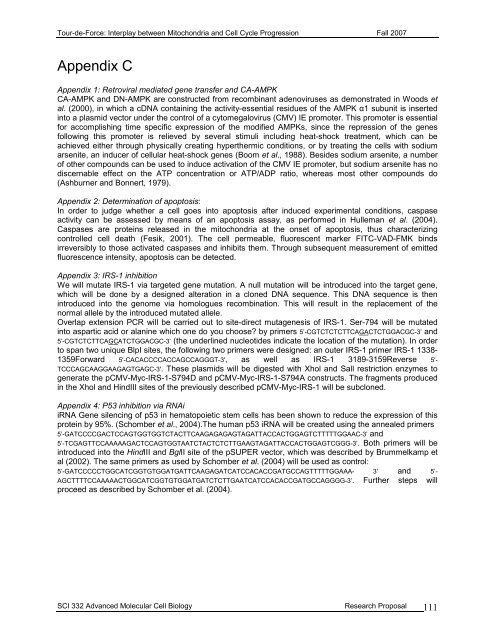Tour-de-Force
Tour-de-Force
Tour-de-Force
Create successful ePaper yourself
Turn your PDF publications into a flip-book with our unique Google optimized e-Paper software.
<strong>Tour</strong>-<strong>de</strong>-<strong>Force</strong>: Interplay between Mitochondria and Cell Cycle Progression Fall 2007Appendix CAppendix 1: Retroviral mediated gene transfer and CA-AMPKCA-AMPK and DN-AMPK are constructed from recombinant a<strong>de</strong>noviruses as <strong>de</strong>monstrated in Woods etal. (2000), in which a cDNA containing the activity-essential residues of the AMPK α1 subunit is insertedinto a plasmid vector un<strong>de</strong>r the control of a cytomegalovirus (CMV) IE promoter. This promoter is essentialfor accomplishing time specific expression of the modified AMPKs, since the repression of the genesfollowing this promoter is relieved by several stimuli including heat-shock treatment, which can beachieved either through physically creating hyperthermic conditions, or by treating the cells with sodiumarsenite, an inducer of cellular heat-shock genes (Boom et al., 1988). Besi<strong>de</strong>s sodium arsenite, a numberof other compounds can be used to induce activation of the CMV IE promoter, but sodium arsenite has nodiscernable effect on the ATP concentration or ATP/ADP ratio, whereas most other compounds do(Ashburner and Bonnert, 1979).Appendix 2: Determination of apoptosis:In or<strong>de</strong>r to judge whether a cell goes into apoptosis after induced experimental conditions, caspaseactivity can be assessed by means of an apoptosis assay, as performed in Hulleman et al. (2004).Caspases are proteins released in the mitochondria at the onset of apoptosis, thus characterizingcontrolled cell <strong>de</strong>ath (Fesik, 2001). The cell permeable, fluorescent marker FITC-VAD-FMK bindsirreversibly to those activated caspases and inhibits them. Through subsequent measurement of emittedfluorescence intensity, apoptosis can be <strong>de</strong>tected.Appendix 3: IRS-1 inhibitionWe will mutate IRS-1 via targeted gene mutation. A null mutation will be introduced into the target gene,which will be done by a <strong>de</strong>signed alteration in a cloned DNA sequence. This DNA sequence is thenintroduced into the genome via homologues recombination. This will result in the replacement of thenormal allele by the introduced mutated allele.Overlap extension PCR will be carried out to site-direct mutagenesis of IRS-1. Ser-794 will be mutatedinto aspartic acid or alanine which one do you choose? by primers 5’-CGTCTCTCTTCAGACTCTGGACGC-3’ and5’-CGTCTCTTCAGCATCTGGACGC-3’ (the un<strong>de</strong>rlined nucleoti<strong>de</strong>s indicate the location of the mutation). In or<strong>de</strong>rto span two unique BlpI sites, the following two primers were <strong>de</strong>signed: an outer IRS-1 primer IRS-1 1338-1359Forward 5'-CACACCCCACCAGCCAGGGT-3', as well as IRS-1 3189-3159Reverse 5'-TCCCAGCAAGGAAGAGTGAGC-3'. These plasmids will be digested with Xhol and Sall restriction enzymes togenerate the pCMV-Myc-IRS-1-S794D and pCMV-Myc-IRS-1-S794A constructs. The fragments producedin the Xhol and HindIII sites of the previously <strong>de</strong>scribed pCMV-Myc-IRS-1 will be subcloned.Appendix 4: P53 inhibition via RNAiiRNA Gene silencing of p53 in hematopoietic stem cells has been shown to reduce the expression of thisprotein by 95%. (Schomber et al., 2004).The human p53 iRNA will be created using the annealed primers5’-GATCCCCGACTCCAGTGGTGGTCTACTTCAAGAGAGAGTAGATTACCACTGGAGTCTTTTTGGAAC-3’ and5’-TCGAGTTCCAAAAAGACTCCAGTGGTAATCTACTCTCTTGAAGTAGATTACCACTGGAGTCGGG-3’. Both primers will beintroduced into the HindIII and BglII site of the pSUPER vector, which was <strong>de</strong>scribed by Brummelkamp etal (2002). The same primers as used by Schomber et al. (2004) will be used as control:5’-GATCCCCCTGGCATCGGTGTGGATGATTCAAGAGATCATCCACACCGATGCCAGTTTTTGGAAA- 3’ and 5’-AGCTTTTCCAAAAACTGGCATCGGTGTGGATGATCTCTTGAATCATCCACACCGATGCCAGGGG-3’. Further steps willproceed as <strong>de</strong>scribed by Schomber et al. (2004).SCI 332 Advanced Molecular Cell Biology Research Proposal 111
















